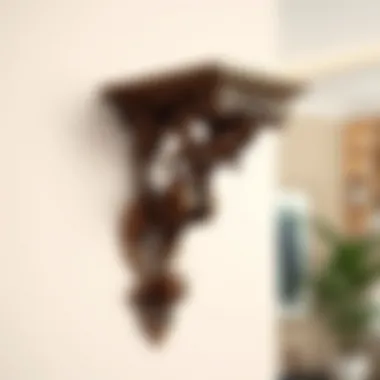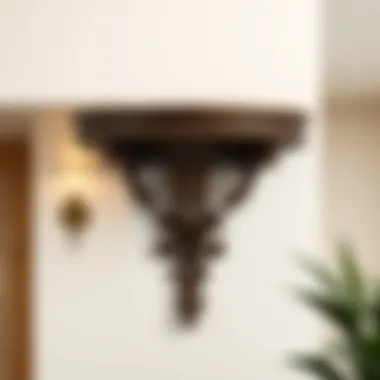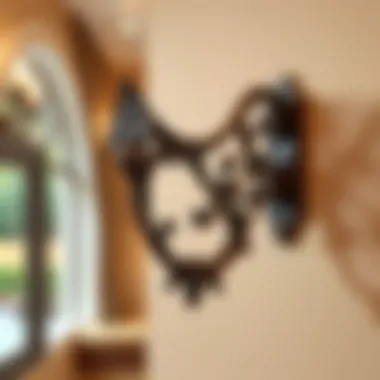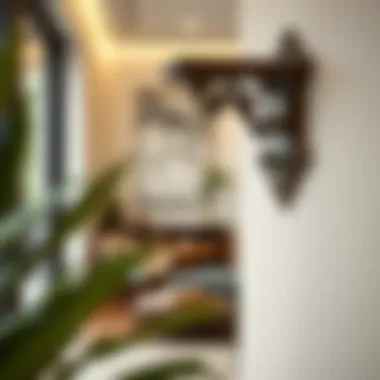Exploring the Beauty of Decorative Wall Brackets


Intro
Wall brackets, often overlooked, have emerged as focal points in interior design. Their unique ability to blend functionality with decorative flair allows homeowners and designers to infuse creativity into any space. From vintage florals to sleek metallic finishes, these fixtures can dramatically alter the perception of a room. Wall brackets serve not only as practical shelves but also as artistic expressions that elevate the overall aesthetic of an environment.
In the following sections, we'll delve into the captivating realm of wall bracket design. We will explore the various styles and trends prevalent today, juxtaposing modern minimalism with traditional craftsmanship. Additionally, we’ll discuss how color and material choices can make or break the success of these decorative pieces, providing practical advice and relevant insights for incorporating them into your home.
Furniture Styles and Trends
Modern vs. Traditional: Understanding the Aesthetics
When it comes to wall bracket design, understanding the dichotomy between modern and traditional aesthetics is vital. Modern designs lean towards simplicity and functionality—think clean lines, smooth surfaces, and a palette that embraces neutral tones. In these designs, brackets can often appear as understated elements that do the job without drawing too much about attention.
Conversely, traditional wall brackets are often characterized by detailed craftsmanship and ornate designs. They might showcase intricate carvings or use rich woods that speak to an era of classic elegance. Adding a traditional wall bracket to a space can invoke feelings of warmth and nostalgia, transforming a mundane wall into a storytelling canvas.
The choices between modern and traditional designs heavily influence not only the visuals but also the overall vibe of a room, making it essential to align these choices with your personal style and the existing decor.
Color and Material Trends: What's In and What's Out
As we assess wall bracket designs, the role of color and materials cannot be disregarded. Currently, there is a notable leaning towards natural materials such as reclaimed wood and stone, which provide an earthy, sustainable feel. Metals, particularly brass and matte black finishes, are making waves in modern decor, delivering a touch of sophistication and contemporary edge.
When it comes to colors, muted hues and earth tones have staked their claim, resonating with a desire for tranquility and comfort in home environments. Glide away from overly vibrant or clashing colors to ensure your brackets harmonize with the larger design narrative.
Epilogue of Trends Analysis
Understanding the contrasting styles and current trends in color and materials can serve as a guiding light for those looking to integrate wall brackets into their interiors. Whether one opts for sleek, modern shapes or ornate, traditional designs, making conscious choices can help transform a room from mundane to magnificent, all thanks to the strategic use of wall brackets.
Intro to Wall Bracket Decorative Design
The world of wall brackets is an often overlooked but pivotal component in decorative design. People may tend to dismiss these elements as mere utility, serving as supports for shelving or fixtures. However, when one looks deeper, it becomes apparent that wall brackets can add not only function but also a unique character to a space. They act like the spices in a dish: subtle yet impactful when used appropriately.
Understanding wall brackets is essential for homeowners, designers, and DIY enthusiasts alike. Whether the goal is to spruce up a dull corner or to create a focal point in a modern interior, the right wall bracket can transform a simple space into an inviting, cohesive area.
When discussing wall bracket decorative design, we need to consider several key elements:
- Variety of Styles: Wall brackets come in myriad styles, from rustic wooden options to sleek metal designs, catering to every taste and aesthetic.
- Integration with Existing Decor: They must harmonize with other elements in a room, ensuring a coherent look rather than a haphazard arrangement.
- Benefits Beyond Functionality: Beyond just supporting items, decorative brackets bring an aesthetic layer that enhances the overall interior theme. They contribute to the ambiance of the space, subtly guiding the observer's eye.
- Careful Selection: Choosing the right wall brackets involves careful consideration of size, material, and color, making it imperative to have a foundational understanding before diving in.
This article aims to elucidate the multifaceted nature of wall brackets and shed light on their significance in interior design. By exploring their historical context, material options, and current trends, readers will get a comprehensive view that serves both functionality and artistry, thereby elevating any interior ambiance.
Historical Overview of Wall Brackets
Understanding the historical context of wall brackets enriches our appreciation for these functional decor items. Wall brackets are not just supports for shelves or general adornments; they are a reflection of the artistic and architectural trends over time. Examining their evolution and cultural significance reveals much about the societies that created them and their intended purposes. By tracing their journey through history, one gains insight into not only design aesthetics but also the shifting priorities and values placed on home decor.
Evolution Through the Ages
Wall brackets have traveled a long road from their inception. In ancient Rome, wall brackets served a practical purpose, to hold items such as oil lamps and small altars. Decoratively simple, they mostly featured utilitarian designs. However, as time went by, the evolution in craftsmanship mirrored advancements in society. The Middle Ages saw a dramatic shift; brackets became more ornate, reflecting the era's Gothic architectural style. They showcased pointed arches and intricate carvings that caught the eye and drew attention to their supportive role.
In the Renaissance, the decorative style of brackets underwent further transformation. Craftsmen began drawing inspiration from nature, and designs included motifs such as leaves and floral patterns, epitomizing the period's embrace of humanism and art. By the time we reach the Baroque era, it’s a whole different ball game. The detailing became exuberant, with curvilinear forms that appear almost animated. These weren’t just brackets anymore—they were statements.
Fast forward to the 20th century, and we find wall brackets evolving yet again. Modernism ushered in a focus on functionality, leading to minimalist designs with clean lines—think sleek metal and lack of ornamentation. Today, wall brackets can be anything from rustic wooden supports in a farmhouse to chic designer pieces made of polished steel. This journey through different eras illustrates not only the aesthetic value of wall brackets but also their significance in the cultural narrative of interior design.
Cultural Significance
Wall brackets are more than just functional items; they carry substantial cultural weight. Across different cultures, they symbolize varying values and aesthetics. In European countries, for instance, the elaborate designs of wall brackets often showcased craftsmanship that was highly regarded during times of prosperity. These pieces served to elevate the space they occupied, indicating the owner's social status while also revealing local artistic practices.
In Asian cultures, wall brackets took on distinct forms as well. For example, traditional Chinese homes would feature brackets known as "dougong" that illustrate advanced joinery techniques, emphasizing a harmony between nature and architectural form. The brackets not only supported roofs but also symbolized balance and stability within the household.
Materials Used in Wall Bracket Decoration
When it comes to wall bracket decorations, the materials used play a crucial role, not just in the aesthetic appeal but also in the longevity and functionality of the brackets. Different materials provide varying benefits, allowing for diverse choices that can cater to specific design needs while ensuring structural integrity. Homeowners, decorators, and design enthusiasts should carefully consider the materials they choose, as they can greatly enhance the overall look and feel of a space.
Wood Options
Types of Wood
Wood brings a warmth that most other materials can't replicate. When selecting the type of wood for brackets, a few standouts come to mind. Maple, known for its fine grain and durability, is often a preferred choice. It lends itself well to intricate designs and holds stain beautifully, enhancing the natural color. Then there's oak, a classic that's tough as nails and brings a rustic charm to any setting. Pine is another solid contender; it's budget-friendly and easy to work with, making it popular among DIYers. These wood types, among others, offer unique characteristics:
- Aesthetic Appeal: The grain, color, and texture of wood can add depth to your décor.
- Adaptability: Wood can fit seamlessly into various design motifs, from traditional to modern.
However, it is essential to acknowledge some drawbacks, such as susceptibility to warping in humid conditions and the need for regular maintenance to keep them looking sharp.
Finishing Techniques
Finishing techniques are where wood truly shines and can be the difference between a good piece and a stunning one. Techniques such as staining can bring out the rich hues of a wood's grain, while varnishing provides a protective layer against scratches and moisture. One standout method gaining traction is rubbed oil finishes, which impart a soft luster without the plastic-like sheen created by polyurethane. The attributes of finishing techniques include:


- Protection: Good finishing protects the wood, ensuring longevity.
- Visual Appeal: Finishes can dramatically alter the appearance, allowing for customization.
It's worth noting that a poorly done finish can lead to peeling and unattractive wear, which means the quality of the finishing process is just as important as the wood itself.
Metal Structures
Variations in Metal Type
Metal structures are a different league altogether when it comes to durability and design sophistication. Options include steel, which is robust and has a sleek aesthetic, making it perfect for modern designs. Aluminum is another favorite; it's lightweight and resistant to corrosion, thus great for both indoor and outdoor use. Not to disregard iron—its strength and vintage vibe make it ideal for traditional styles. Key characteristics of metal types include:
- Strength: They can carry heavier loads without bending or breaking.
- Modern Appeal: Metals can bring a chic, industrial edge to design.
Despite their merits, they also come with potential downsides, such as susceptibility to rusting (especially iron) without proper treatment, adding to maintenance responsibilities.
Durability and Maintenance
One of the prime reasons metal is sought after is its durability. In wall bracket design, metal can withstand significant wear and tear, often lasting far longer than wood counterparts. It also requires less upkeep, though that doesn't mean it’s maintenance-free. Regular cleaning to remove dust and ensuring protective coatings are intact can keep metal looking new for years. Pros and cons of this approach include:
- Longevity: Well-maintained metal can outlast many other materials.
- Less Frequent Maintenance: Unlike wood, metals require less ongoing care, which can be a boon for busy homeowners.
However, if neglected, metal can lose its luster and may develop rust, especially if exposed to moisture without protection in place.
Glass Incorporation
Design Versatility
Incorporating glass into wall bracket designs offers a unique blend of transparency and elegance. Glass brackets can serve as a stunning visual element without overwhelming a space. Options range from frosted to clear, allowing homeowners to choose how much light and visibility they desire. This versatility means:
- Light Enhancement: By reflecting light, glass can brighten up even the dullest corners.
- Modern Look: It can seamlessly integrate with contemporary designs, enhancing minimalist sensibilities.
However, while glass offers beauty, it may be prone to scratching and requires careful handling, making it a less practical choice for some applications.
Installation Considerations
Installing glass brackets is different than working with wood or metal. It often requires precise measurements and secure fittings to avoid breakage. Using specialized adhesives or brackets designed for glass installation might be necessary to ensure a safe and effective mount. Essential aspects to consider:
- Secure Mounting: Ensuring that the glass is securely affixed to prevent accidents is paramount.
- Professional Help: Due to the fragility of glass, consulting professionals for installation might save headaches down the line.
On the downside, if mishandled during installation, there is a risk of breakage, and that could lead to costly replacements.
Styles of Wall Bracket Decorations
The aesthetics of a space can often be refined, even elevated, with the careful selection and installation of wall brackets. Styles of wall bracket decorations vary widely, reflecting personal tastes and the overall tone of the room. By understanding these styles, homeowners and decorators can better integrate these fixtures into their interiors, creating harmony and visual appeal.
Elements such as the shape, material, and intricate details each play vital roles in achieving the desired look and functionality. Moreover, choosing the right style can accentuate the character of a room, making it not just livable but also inviting.
Traditional Designs
Classic Shapes
Classic shapes in wall brackets embody a richness that is often associated with timeless elegance. These shapes tend to be symmetrical and follow traditional aesthetic principles, making them ideal for historical or classical interior designs. The appeal of classic shapes lies in their familiarity.
A prominent feature of these designs is the ornate curve, often seen in Victorian or Baroque styles. This characteristic allows classic brackets to complement various decorative elements, enhancing the room without overshadowing other features. Their popularity persists as they fit seamlessly into various decors, from opulent living rooms to cozy reading nooks.
Yet, the primary drawback could be their sometimes bulky appearance. In smaller rooms, these shapes may overwhelm the space, leading to a cluttered feel. However, if utilized correctly, they serve as focal points rather than distractions.
Intricate Details
The charm of intricate details in wall brackets cannot be overstated. These designs often feature carvings, lines, and embellishments that tell a story, adding personality to a space. Detail-rich brackets can transform an otherwise plain area into one that sparks intrigue and admiration.
Key characteristic of intricate details is the craftsmanship that goes into their design. Whether it's floral patterns or detailed motifs, these features uplift the aesthetic while giving a nod to artistry. This choice can be particularly beneficial for locales looking to convey sophistication or historical depth.
However, a potential disadvantage is maintenance; intricate designs might collect dust and require careful cleaning to preserve their beauty. Still, their ability to evoke sentiments and memories often outweighs the chores involved in upkeep.
Modern Aesthetics
Sleek Lines
In contrast to traditional structures, sleek lines epitomize contemporary design philosophies. Featuring clean, straight lines with a refined silhouette, modern wall brackets offer minimalistic beauty. This style is particularly sought after in urban settings where space is at a premium.
The simplicity of sleek lines emphasizes functionality, allowing these brackets to support artwork or lighting without drawing undue attention. Their understated elegance is a beneficial choice for those in search of a streamlined look.
Nonetheless, while they might appeal to the minimalists, sleek lines may lack the ornamentation that some prefer in their decor. If a room is overly minimalistic, it could appear stark or cold—balancing with other textures and styles becomes essential.
Minimalist Approaches
Minimalism as a design choice focuses on the idea that less is more. Minimalist wall brackets often forgo excessive features in favor of a more utilitarian form. These designs are largely defined by their functionality
combined with simple aesthetics.


Their key characteristic is an emphasis on uncluttered spaces; this approach fosters a sense of tranquility, making these brackets highly popular in modern homes. The practical design ensures they serve their primary purpose without unnecessary embellishments.
However, the minimalist approach can be a double-edged sword. In adding minimal features, some homeowners may sacrifice the visual warmth that more detailed brackets would provide. Therefore, the visual impact feels more subdued; it is crucial to pair minimalist brackets with appropriate decor to keep the space lively.
Eclectic Combinations
Mixing Materials
The trend towards mixing materials in wall bracket designs speaks to the eclectic nature of contemporary interiors. Combining wood, metal, and even glass, this approach offers unparalleled versatility. Each material brings its unique flair, allowing creative freedom.
A significant benefit of mixing materials is the ability to cater to various tastes and themes, creating bespoke solutions. For instance, a wooden bracket with metal accents could provide a rustic yet industrial touch to a room.
That said, one must approach this style carefully. Over-mixing could lead to chaos in design, rendering the space disjointed. A cohesive vision must remain at the forefront when experimenting with varying materials.
Layering Styles
Layering styles in wall bracket decoration encourages an artistic expression that bridges the traditional and modern. This approach involves intermingling different styles, like combining a minimalist bracket with a classic ornately designed piece.
The key characteristic here is the dynamic visual interest it brings into a space. Layering diversifies the decor, allowing homeowners to reflect their personality through contrast and harmony. Notably, layering can accentuate depth and richness in a room.
However, as with mixing materials, there lies a risk of confusion in design; adhering to a theme is important to create a cohesive overall look. Too many styles layered without thoughtful design can cause visual clutter and detract from individual elements.
Above all, in the realm of wall bracket decorative design, an understanding of styles is crucial for achieving balance and beauty. Whether leaning toward traditional elegance with intricate details or embracing the boldness of eclectic combinations, the appropriate wall brackets can breathe life into any interior space.
Practical Considerations for Installation
When it comes to installing wall brackets, practical considerations play a crucial role in ensuring both functionality and aesthetic appeal. Successful installation can enhance the overall style of a room, adding an elegant touch while keeping items securely in place. This section will delve into the essential aspects of installation, emphasizing the importance of strategic planning, the proper tools, and safety measures.
Choosing the Right Location
The placement of wall brackets is no small potatoes; it can significantly influence the entire look of a space. Selecting the right location involves a few key factors:
- Purpose: Ask yourself what you intend to achieve with the wall bracket. Are you aiming to display artwork, hold a shelf, or mount a light fixture?
- Height and Visibility: Mounting brackets too high can leave items out of reach, while too low might disrupt the visual harmony of the room. A good rule of thumb is to ensure visibility without compromising functionality.
- Wall Strength: Some walls are sturdier than others. For wooden or dry-walled surfaces, using brackets that can handle the weight is essential.
A simple way to determine the right spot is to mark potential locations with painter's tape. This allows you to visualize and assess the alignment before making any permanent decisions. After all, measure twice and drill once can save a headache down the line.
Tools Required
Like a carpenter with a toolkit, proper tools are necessary for a smooth installation process. Here's a concise list of essential equipment:
- Drill: A power drill is your best friend for creating holes and driving screws into the wall.
- Screwdrivers: Keep both phillips and flat-head screwdrivers handy to fit various screws.
- Level: Ensures your brackets are placed evenly, avoiding a lopsided effect that can detract from the decor.
- Stud Finder: Locating wall studs is pivotal for securing heavier items safely.
- Measuring Tape: Precision counts, especially when calculating the distance between multiple brackets.
Equipping yourself with these tools can save you from the common pitfalls many experience during installations.
Safety Measures
Safety should never take a backseat during your installation efforts. Here are some crucial tips to keep in mind:
- Protective Gear: Don safety goggles to shield your eyes from dust and debris. Gloves can also protect your hands from sharp edges or mishaps.
- Clear Workspace: Maintain a tidy work area to minimize trip hazards. A clutter-free environment can greatly reduce accidents.
- Check for Utilities: Before drilling into walls, it’s advisable to check for electrical wires or plumbing that might be hidden behind.
"An ounce of prevention is worth a pound of cure."
Enhancing Aesthetic Appeal with Wall Brackets
When it comes to interior design, wall brackets might not be the first feature on one’s mind. However, these decorative objects play a crucial role in enhancing the aesthetic appeal of a space. They serve not only as functional supports but also as design elements that can elevate a room from mundane to extraordinary. Understanding their significance helps homeowners and designers alike to make informed choices that reflect their personal style while amplifying the overall environment.
The beauty of wall brackets lies in their versatility. They can adapt to various decor styles, from rustic charm to sleek modernity, making them an essential part of any designer's toolkit. Furthermore, they assist in organizing spaces, displaying art and lighting features tactically, thereby contributing to a well-thought-out design narrative. Without losing sight of their functionality, an eye-catching bracket can frame artworks beautifully, cast interesting shadows, or even accentuate architectural features in a room, beckoning visitors to take a closer look.
Lighting Innovations
Types of Light Fixtures
One cannot talk about enhancing an interior's appeal without mentioning lighting. Wall brackets often incorporate light fixtures, illuminating spaces while further contributing to decorative aesthetics. From sconces to integrated LED elements, each type serves a specific purpose in the grand scheme of design.
- Sconces: These are the classic choice and offer a warm glow, perfect for hallways and entry points. Their primary advantage is the ability to create a cozy atmosphere, usually featuring a varied selection of shades and finishes.
- Integrated LEDs: These modern fixtures meld seamlessly with the brackets, presenting a clean and contemporary look that's often adjustable in brightness.
- Unique Feature: The ability to direct light upwards provides a gentle wash of illumination, softening the ambiance.
- Disadvantages: Depending on the design, sconces can sometimes overpower smaller spaces if not sized correctly.
- Unique Feature: They allow for effective task lighting, ideal for reading nooks or art displays.
- Disadvantages: Their installation can be more complex, requiring electrical knowledge, which can deter some homeowners.
Impact on Atmosphere
Lighting fundamentally alters how a room is perceived. The right wall-mounted fixtures provide more than mere illumination; they set the mood and tone of a space. Selecting fixtures strategically can bring warmth to a cold room or introduce dramatic flair in contemporary spaces.


- Warm Lighting: Generally preferred in living areas, it invokes comfort and intimacy, making spaces feel more welcoming.
- Cool Lighting: Ideal for kitchens or modern offices, it enhances productivity and creates a clean, fresh vibe.
- Unique Feature: It complements natural colors, tying together interior elements effortlessly.
- Disadvantages: Sometimes, overly warm light can appear yellowish and affect the true colors of art or décor.
- Unique Feature: Gives clarity, making tasks easier and fostering focus.
- Disadvantages: Without care, cool light can sometimes feel sterile or overly harsh, disengaging the warmth of home.
Supporting Artwork and Decor
When considering wall brackets, it’s essential to delve into how they can support art and accentuate existing decor. This path not only weaves a strong aesthetic narrative but also truly highlights personal taste.
Framing Techniques
One might overlook the way brackets can frame art pieces. Using a bracket to hold or elevate artwork highlights details that might otherwise be missed, transforming a simple display into a focal point of interest.
- Floating Frames: Elevate three-dimensional objects while maintaining depth. This technique brings a touch of modernity to traditional wall setups.
- Layered Displays: Using multiple brackets, different sizes can create a gallery wall effect. This aspect adds dynamics to visual storytelling.
- Unique Feature: This approach allows for creativity, enabling homeowners to display intricate or unusual pieces.
- Disadvantages: It may require special brackets that can accommodate art securely while ensuring they remain unobtrusive.
- Unique Feature: Each layer can reflect personal stories or memories, adding a personalized touch to any space.
- Disadvantages: A cluttered approach could overwhelm a room, so careful planning is advisable.
Creating Visual Balance
Visual balance in design ensures that one area doesn’t overshadow another, which is critical in a well-composed room. Wall brackets contribute significantly to this balance by tying elements together in thoughtful arrangements.
- Symmetry with Wall Brackets: Using brackets of equal height to flank a piece of art creates an alluring symmetry, fostering a cohesive look. It evokes harmony, making spaces feel orderly and resolved.
- Asymmetrical Arrangements: By employing varying bracket heights or styles, an engaging dynamic form emerges, catching the eye and inviting curiosity.
- Unique Feature: This visual alignment can guide the eye and bring forth a sense of calm.
- Disadvantages: Overemphasis on symmetry can sometimes stifle creativity, leading to more predictable designs.
- Unique Feature: It creates a sense of movement, making the design feel alive and evolving.
- Disadvantages: This technique runs the risk of feeling chaotic if not executed with an overall theme or purpose in mind.
Emerging Trends in Wall Bracket Decor
The world of wall bracket decorative design is continuously changing, just like fashion trends. Emerging trends play a vital role in shaping how homeowners and interior designers approach their decor. Keeping an eye on what's fresh and new can offer unique opportunities for creativity and innovation in home spaces. Influenced by sustainable practices and smart technology, these trends highlight a blend of functionality and artistry, appealing to those looking for more than just basic decor.
Sustainable Materials
Eco-Friendly Choices
When talking about eco-friendly choices in wall bracket decor, one must consider the materials that minimize environmental impact while adding beauty to a space. Often made from natural fibers or responsibly sourced woods, these materials showcase a commitment to sustainability. The key characteristic here is that these selections aren’t only good for Mother Earth; they're also beautiful. Using bamboo or reclaimed wood provides a rustic charm that is quite popular in modern interior designs.
The unique feature of eco-friendly materials lies in its versatility; they can be used in various styles, from contemporary to traditional. In this article, one has to note that though they might come with a slightly higher price tag, the long-term benefits, like durability and reduced maintenance, often offset the initial expense.
Reclaimed Designs
Reclaimed designs have gained a lot of traction recently—probably because they tell a story and promote sustainability at the same time. Made from salvaged materials, these brackets often boast distinctive textures and colors unique to their origin. This aspect appeals to many homeowners seeking character in their decor. What’s more, reclaimed wood is often sourced from old buildings or furniture, which adds an element of history and uniqueness. However, one must be wary; while reclaimed designs can be aesthetically pleasing, they might require more maintenance than standard materials, particularly if the wood wasn't treated appropriately. This aspect could deter some buyers, but for those enthusiastic about preserving history and reducing waste, the charm far outweighs the drawbacks.
Smart Technology Integration
In today's high-tech world, smart technology integration is reshaping the possibilities available for wall bracket decor. Imagine a scenario where your wall brackets are not just functional but also enhance smart lighting systems or actively communicate with your home automation setups. This tech-savvy approach allows for real-time adjustments, optimizing both aesthetics and ambiance. Bluetooth-enabled lights, dimmers that can be controlled via smartphone apps, or even voice-activated designs offer a thrilling glimpse into the future of interior decor. The appeal lies not only in their practicality but also in their capacity to elevate the everyday living experience—blending art with convenience and intelligence.
As wall bracket designs continue to evolve with technological advancements, staying attuned to these emerging trends can transform ordinary spaces into extraordinary environments, offering both style and function.
In summary, embracing emerging trends in wall bracket decor can breathe new life into a home while also contributing to a more sustainable future. As we explore more about styles, materials, and innovative technology, it becomes clear that these developments are not just trends—they are paving the way for the future of interior design.
Finale: The Impact of Wall Bracket Decorative Design
In the grand tapestry of interior design, wall brackets often play a subtle yet pivotal role. They've come a long way from mere fixtures that support loads to vibrant expressions of artistry that can fundamentally alter the character of a space. This exploration of wall bracket decorative design highlights their significance—not only in terms of practicality but also in shaping an aesthetic environment.
When done right, wall brackets can coordinate functionality with artistic flair. They hold shelves, display decor, or support lighting fixtures, providing essential support while also creating visual intrigue. By integrating thoughtful designs and unique materials, such as reclaimed wood and sleek metals, homeowners can enhance the impact of any room.
Moreover, wall brackets offer great flexibility in design, allowing individuals to reflect their personal style. Whether leaning towards the ornate charm of baroque influences or seeking the clean lines of contemporary minimalism, there's a wall bracket to fit every narrative. This variety serves to inspire homeowners and designers alike to embrace wall brackets as more than just practical tools, but as integral components of their overall design scheme.
"Wall brackets are like the finishing touches to a well-set table; they complete the whole without stealing the show."
Yet, as with any design choice, it's essential to consider the space's flow and purpose. A well-placed wall bracket can serve as a focal point, drawing the eye and creating an enhanced engagement with the surrounding environment. On the flip side, a poorly chosen bracket might feel awkward or forced, detracting from the aesthetic flow. Thus, balancing form and function becomes crucial in masterfully utilizing wall brackets in design.
As trends evolve, we continue to see innovations that tether these fixtures to sustainable practices and smart technology, further expanding their role in modern interiors. Understanding these emerging trends not only brings a fresh perspective to traditional designs but also encourages exploration into what can be achieved through creative juxtaposition.
In summary, the impact of wall bracket decorative design extends far beyond mere aesthetics. It encompasses a blend of functionality, personal style, and the thrill of innovation. As such, integrating wall brackets into your home’s decor opens a world of opportunities to elevate both style and functionality.
Final Thoughts on Functionality and Aesthetics
The balance between functionality and aesthetics remains at the core of effective wall bracket design. While these decorative pieces serve essential roles, their design must not be overlooked. A wall bracket that is visually appealing can become a centerpiece, enriching the overall design narrative of a room. This symbiotic relationship between looks and utility can be the difference between a simple space and one that speaks volumes of its owner's taste.
For instance, consider a vintage iron wall bracket supporting a distressed wooden shelf. The combination not only upholds functionality but also exudes charm that resonates with a rustic interior style. Homeowners and designers alike find that integrating thoughtful brackets can transform walls into rich canvases that tell a story.
Encouragement for Exploration
Visitors to the realm of wall bracket design should approach with curiosity and an open mind. The potential for creativity is endless. From DIY projects using upcycled materials to selecting bespoke items from artisanal creators, exploring different styles and ideas can foster unique spaces that reflect personal narratives and character.
Engaging with forums and communities, such as those on reddit.com, can provide inspiration and practical tips. Additionally, learning from established guidelines and references from sources like britannica.com or wikipedia.org can offer a solid foundation.
So, don't shy away from experimenting. Let the journey of enhancing your home with wall bracket decorative designs be one of discovery, allowing your walls to come alive and contribute to the ambiance of your living space.















